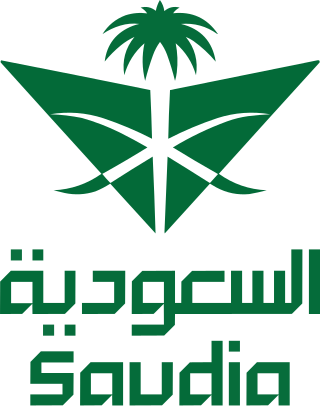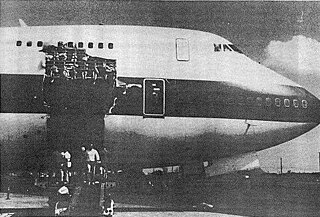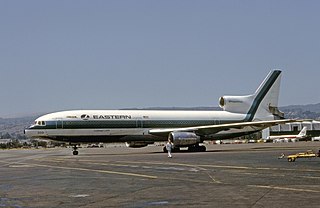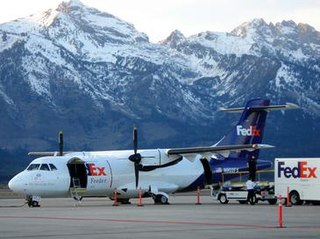
Saudia, formerly known as Saudi Arabian Airlines, is the flag carrier of Saudi Arabia, based in Jeddah. The airline's main hub is at King Abdulaziz International Airport in Jeddah and King Khalid International Airport in Riyadh, with it planning to pull out of Riyadh as a major hub by 2030.

The Lockheed L-1011 TriStar is an American medium-to-long-range, wide-body trijet airliner built by the Lockheed Corporation. It was the third wide-body airliner to enter commercial operations, after the Boeing 747 and the McDonnell Douglas DC-10. The airliner has a seating capacity of up to 400 passengers and a range of over 4,000 nautical miles. Its trijet configuration has three Rolls-Royce RB211 engines with one engine under each wing, along with a third engine center-mounted with an S-duct air inlet embedded in the tail and the upper fuselage. The aircraft has an autoland capability, an automated descent control system, and available lower deck galley and lounge facilities.

The McDonnell Douglas DC-10 is an American trijet wide-body aircraft manufactured by McDonnell Douglas. The DC-10 was intended to succeed the DC-8 for long-range flights. It first flew on August 29, 1970; it was introduced on August 5, 1971, by American Airlines.
This is a list of aviation-related events from 1980.

Turkish Airlines Flight 981 (TK981/THY981) was a scheduled flight from Istanbul Yeşilköy Airport to London Heathrow Airport, with an intermediate stop at Orly Airport in Paris. On 3 March 1974, the McDonnell Douglas DC-10 operating the flight crashed into the Ermenonville Forest, 37.76 kilometres (23.46 mi) outside Paris, killing all 335 passengers, and 11 crew on board. The crash was also known as the Ermenonville air disaster. Flight 981 was the deadliest plane crash in aviation history until 27 March 1977, when 583 people died in the Tenerife airport disaster. It remains the deadliest single-aircraft accident without survivors, the second hull loss and the deadliest accident involving the McDonnell Douglas DC-10, and the deadliest aviation accident to occur in France.

Delta Air Lines Flight 191 was a regularly scheduled Delta Air Lines domestic service from Fort Lauderdale, Florida, to Los Angeles with an intermediate stop at Dallas/Fort Worth International Airport (DFW). On August 2, 1985, the Lockheed L-1011 TriStar operating Flight 191 encountered a microburst while on approach to land at DFW. The aircraft impacted ground just over one mile (1.6 km) short of the runway, struck a car near the airport, collided with two water tanks, and disintegrated. 137 people died and 25 others were injured in the crash. The National Transportation Safety Board (NTSB) determined that the crash resulted from the flight crew's decision to fly through a thunderstorm, the lack of procedures or training to avoid or escape microbursts, and the lack of hazard information on wind shear. Forecasts of microbursts improved in the following years, with USAir Flight 1016 being the only subsequent microburst-induced crash of a commercial, fixed-wing aircraft in the United States as of 2024.

Saudia Flight 163 was a scheduled Saudia passenger flight departing from Quaid-E-Azam Airport in Karachi, Pakistan, bound for Kandara Airport in Jeddah, Saudi Arabia, via Riyadh International Airport in Riyadh, Saudi Arabia, which caught fire after takeoff from Riyadh International Airport on 19 August 1980. Although the Lockheed L-1011-200 TriStar made a successful emergency landing at Riyadh, the flight crew failed to perform an emergency evacuation of the airplane, leading to the deaths of all 287 passengers and 14 crew on board the aircraft from smoke inhalation.

Cameroon Airlines was an airline from Cameroon, serving as flag carrier of the country. Based in Douala, it operated scheduled services within Africa, as well as to Europe and the Middle East out of its hub at Douala International Airport, with a second network focus on Yaoundé Nsimalen International Airport. The company was 96.43 percent state-owned, with the remaining shares having been held by Air France. It ceased operations in March 2008; its role as Cameroon's flag carrier was taken over by Camair-Co. The company slogan was French: Pour mieux vous servir, To serve you better.

United Airlines Flight 811 was a regularly scheduled airline flight from Los Angeles to Sydney, with intermediate stops at Honolulu and Auckland. On February 24, 1989, the Boeing 747-122 serving the flight experienced a cargo-door failure in flight shortly after leaving Honolulu. The resulting explosive decompression blew out several rows of seats, killing nine passengers. The aircraft returned to Honolulu and landed without further incident.
King Salman Air Base, formerly known as Riyadh Air Base until 2015 with the commencement of "Decisive Storm" and formerly known as Riyadh International Airport from its opening in 1946 until 1983, was a military air base in Riyadh, Saudi Arabia. It was originally used by Saudia as an airline hub before King Khalid International Airport opened in 1983.

TWA Flight 843 was a scheduled Trans World Airlines passenger flight that crashed after an aborted takeoff from John F. Kennedy International Airport to San Francisco International Airport (California) in July 1992. Despite an intense fire after the crash, the crew was able to evacuate all 280 passengers from the aircraft. There was no loss of life, although the aircraft was destroyed by the fire.

Nigeria Airways Flight 2120 was a chartered passenger flight from Jeddah, Saudi Arabia, to Sokoto, Nigeria, on 11 July 1991, which caught fire shortly after takeoff from King Abdulaziz International Airport and crashed while attempting to return for an emergency landing, killing all 247 passengers and 14 crew members on board. The investigation traced the fire to underinflated tires which overheated and burst during takeoff, and subsequently discovered that a project manager had prevented those tires from being replaced because the aircraft was behind schedule. The aircraft was a Douglas DC-8 operated by Nationair Canada for Nigeria Airways. Flight 2120 is the deadliest accident involving a DC-8 and the deadliest aviation disaster involving a Canadian airline.

TACA Flight 390 was a scheduled flight on May 30, 2008, by TACA International from San Salvador, El Salvador, to Miami, Florida, United States, with intermediate stops at Tegucigalpa and San Pedro Sula in Honduras. The aircraft, an Airbus A320-233, overran the runway after landing at Tegucigalpa's Toncontín International Airport and rolled out into a street, crashing into an embankment and smashing several cars in the process.
Air France has been in operation since 1933. Its aircraft have been involved in a number of major accidents and incidents. The deadliest accident of the airline occurred on June 1, 2009, when Air France Flight 447, an Airbus A330-203, flying from Rio de Janeiro to Paris crashed into the Atlantic Ocean with 228 fatalities. A selected list of the most noteworthy of these events is given below.

On May 5, 1983, a Lockheed L-1011 TriStar, registration N334EA, operating as Eastern Air Lines Flight 855 en route from Miami International Airport to Nassau International Airport, experienced the loss of all three engines near Miami, Florida. The flight crew succeeded in restarting one engine in time to safely land the aircraft at Miami International Airport.
Several aviation incidents and accidents have occurred in which the control surfaces of an aircraft became disabled, often due to failure of hydraulic systems or the flight control system. Other incidents have occurred where controls were not functioning correctly prior to take-off, either due to maintenance or pilot error, and controls can become inoperative from extreme weather conditions. Aircraft are not designed to be flown in such circumstances; however, a small number of pilots have had some success in flying and landing aircraft with disabled controls.

Eastern Air Lines Flight 935 was a scheduled commercial passenger flight operated by Eastern Air Lines. On September 22, 1981, the Lockheed L-1011 TriStar jet operating the flight suffered an uncontained engine failure which led to a loss of 3 out of the 4 hydraulic systems aboard the aircraft at an altitude of 10,000 feet (3,000 m) MSL. The crew were able to land the aircraft safely to an emergency landing at John F. Kennedy International Airport with some limited use of the outboard spoilers, the inboard ailerons and the horizontal stabilizer, plus differential engine power of the remaining two engines. There were no injuries.

Empire Airlines Flight 8284 was a cargo flight operated by Empire Airlines for FedEx Feeder from Fort Worth Alliance Airport to Lubbock Preston Smith International Airport, Texas. On January 27, 2009, it crashed on final approach to its destination. Both crew members survived with minor injuries but the aircraft was written off.














